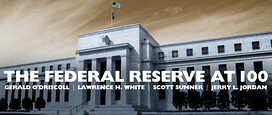Gerald O’Driscoll has raised a number of interesting issues in a reply to my comments. Here he contrasts the classical gold standard with a gold exchange standard:
The post-World War I gold standard operated quite differently, and is known in the literature as a gold-exchange standard. Central banks economized on reserves and engaged in the sterilization of reserves that Sumner describes. Both systems (pre- and post-World War I) were called the gold standard, but they were in reality two different systems. Nineteenth century economists like David Ricardo understood the differences very well. Modern economists often conflate them. The global monetary system failed in the 1930s precisely because of the differences between the pre- and post-World War I “gold standards.”
I see the situation slightly differently. It is true the gold exchange standard economized on gold reserves, but only up until the late 20s. This is why the interwar price level was higher than the pre-World War I price level. The real problem was that key central banks began to move back towards the classical gold standard in the early 1930s. By 1933 prices had fallen back close to the prewar level, as central banks replaced currency reserves with gold. The problem wasn’t so much the gold exchange standard or the classical gold standard, but rather that transitioning from a gold exchange standard toward a classical gold standard is extremely deflationary.
Mr. O’Driscoll also argues that the Great Inflation was a result of deliberately expansionary monetary policies, not policy mistakes. But why not both? Let’s suppose that during the 1960s policymakers had a “naïve” view of the Phillips curve. They assumed that the trade-off between inflation and unemployment was permanent. They assumed that the Fed could buy lower unemployment with a bit more inflation. We now know that this is wrong, but it appears to have been widely believed at the time. This mistaken view of the Phillips curve led policymakers to adopt an expansionary monetary policy, assuming that they could generate low unemployment with perhaps 3% inflation. They were wrong, and instead we ended up with 13% inflation by 1980. Had they known in 1965 that this sort of monetary policy would lead to 13% inflation, policy might well have been less expansionary in the late 1960s. Yes, Mr. Burns appears to have been corrupt, but surely not all 12 FOMC members were corrupt?
Mr. Driscoll argues that a sounder fiscal policy allowed the Fed to bring down the rate of inflation:
Given this record, I cannot agree that in the 1980s and 1990s “central banks were given greater independence, either tacitly or officially.” There were no official changes, certainly not for the Fed. What changed in many countries was the move away from chronic fiscal deficits.
And yet in the United States fiscal policy became substantially more expansionary during the 1980s as deficits increased under a policy of tax cuts and higher military spending. At the same time, the inflation rate fell sharply, a result that contributed in no small part to the replacement of old Keynesianism with new Keynesianism. Of course we’ve seen the same pattern since 2008, vastly larger deficits and lower inflation.
We also disagree on nominal GDP targeting:
My main question about NDGP targeting, which I have asked Sumner in other forums, is how is the rule going to be enforced? Rules are not generally self-enforcing. If Congress were to mandate some form of NGDP targeting, what incentives do Fed officials have to follow it?
I have advocated the creation of nominal GDP futures markets, which would allow the market to set the money supply and interest rates at a level expected to lead to on target nominal GDP growth. A purely automatic system. However, I strongly believe that nominal GDP targeting, level targeting, could work reasonably well under our under current monetary policy set up. Not perfectly, but reasonably well.
In recent decades the Fed has aimed for roughly 2% inflation, and the policy outcome has been far from optimal. But it’s important to note that the reason for this suboptimal policy outcome is not a failure to keep inflation close to 2%. In fact the rate of inflation in the United States and Canada has been relatively close to 2% for several decades. So I have no reason to doubt that the central bank is able to adhere to a nominal target. The real problem is that 2% inflation is not consistent with macroeconomic stability, whereas stable growth in nominal GDP would be consistent with macroeconomic stability.
I don’t believe that Congress has the expertise required to set a specific macroeconomic target, but rather should set a broad outline, such as the “dual mandate” for stable prices and high employment. Then it’s up to economists in academia and at the Federal Reserve to translate these broad goals into a coherent policy rule. There is a general consensus that monetary policy cannot raise employment in the long run. Thus the Fed has quite reasonably interpreted “high employment” as an unemployment rate close to the natural rate. And stable prices have been interpreted as a low but positive rate of inflation for various reasons. Because it’s very difficult to estimate the natural rate of unemployment, I believe that nominal GDP targeting is a more effective way of addressing the broad goals Congress laid out in the dual mandate (as compared to alternatives such as the Taylor Rule).

